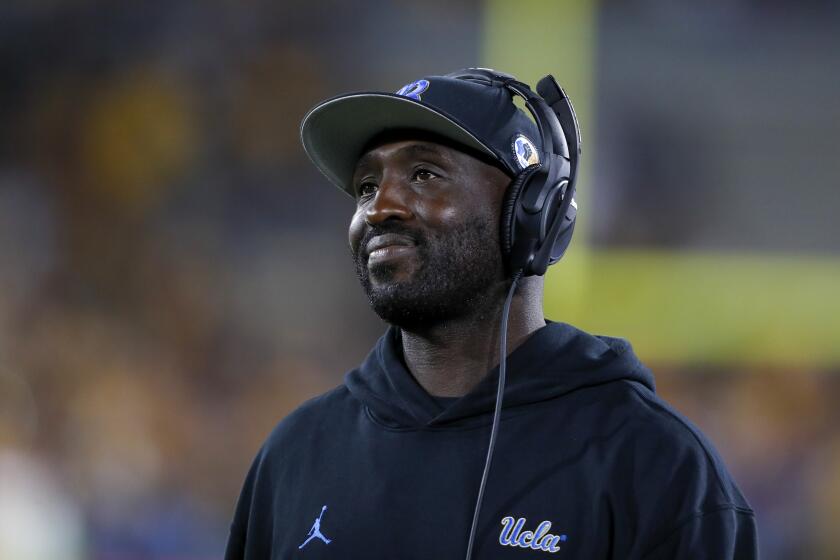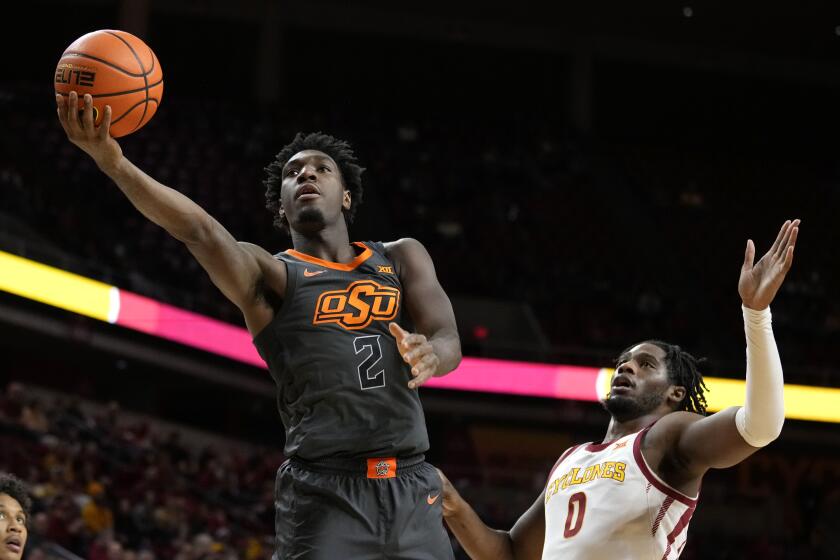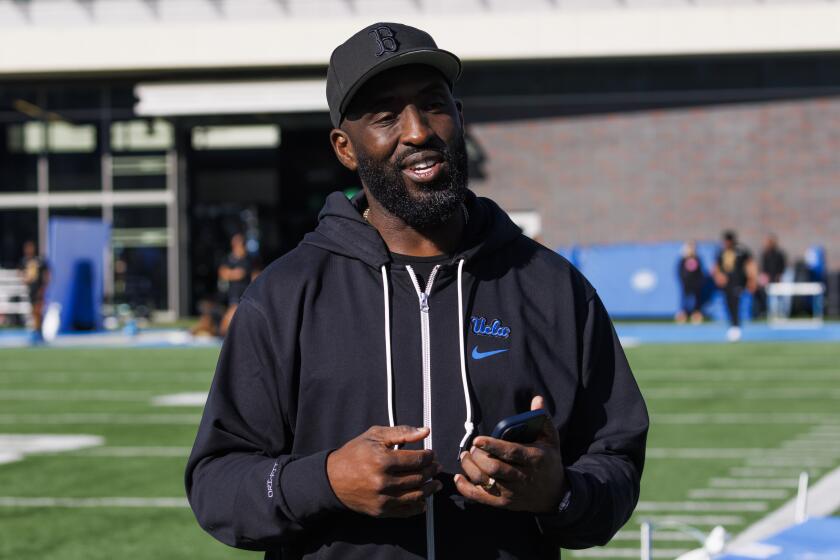Sneaky moves in heart of Texas
The titular head of college football’s most dysfunctional family will be in town Saturday. Texas will play UCLA at the Rose Bowl.
For many officials in the traveling Texas contingent, attending a football game will be a great escape from the realities back home.
If Big 12 football were a movie about a family, Marlon Brando would play Texas. These days, the rest of the conference is quite unhappy with its godfather. Other members feel that Texas has decided to take its rallying call literally.
Hook ‘em Horns.
This is a story more complicated than a Peyton Manning audible. It includes the perceived fraud of major college football masquerading as education; also, a sanctioning body, the NCAA, so huge and complex that the right hand doesn’t seem to know it even has a left hand. Add to that a cable television behemoth, ESPN, so intent on ruling and/or owning the sports world that any journalistic principles once pondered are now squashed under the wheels of Brink’s trucks.
Since this is a story best suited for a James Michener-length book, you will get just the CliffsNotes.
Three weeks ago, the University of Texas launched the Longhorn Network. LHN, for those keeping score at home.
It was a first. Never before has a university had its own sports network, dedicated to its own teams. Conferences have networks. There is gold in them thar hills. The Big Ten, for example, has, by one report, distributed $20 million a year per school from network proceeds. Notre Dame has a deal with NBC to televise its home games, but its football team is not in a conference.
The tectonic plates upon which college football rested started to slip last year, the year after Larry Scott joined the Pac-10 as its new commissioner. He sought to expand the Pac-10, and has, with the addition this season of Colorado and Utah.
But his original vision was bigger, and it included no less than Texas, which played it coy for a while as the rest of the family panicked. When the smoke cleared, the Longhorns stayed in the Big 12, and as sort of a consolation prize, were given the OK by other conference members to have their own network. Apparently, the family underestimated the guile and gall of the godfather.
On Jan. 19, in a detailed news release, Texas announced it would go ahead with the network. There was no immediate outcry.
Soon, ESPN was winning the bid to partner with Texas in LHN, along with marketing giant IMG. The total deal was $300 million for 20 years, with IMG getting about $50 million in credit from Texas. Having the eyes of Texas upon you, day and night, was expensive.
The day after the announcement, SI.com raised an obvious red flag, while joking that Texas would “take the $300 million, buy Nebraska and donate it to charity.” The red flag? Texas planned to use LHN to televise prep football games. The SI.com story joked about the foolishness of that and found an NCAA rule that translated to: Member schools can’t put recruits on TV. It is rule 13.10.3.2.
Who needs rules? Logic should have been enough. Televising the game of a recruit on your own network creates a grossly unfair recruiting advantage. Duh. Allow that and it is game over for the rest of the conference. Heck, the rest of college football.
Soon, ESPN weighed in and screwed up. Dave Brown, LHN general manager, was quoted July 19 not only backing the prep plan, but also rationalizing its existence like some slobbering fan. He said LHN would televise games involving a Texas non-signee, Johnathan Gray, who had made a verbal commitment, and even try to go as far as Arizona for games of another unsigned prep star verbally committed to the Longhorns.
“People are going to want to see Johnathan Gray,” Brown said. “I can’t wait to see Johnathan Gray.”
Eventually, Texas A&M; woke up. Televising prep games on an archrival’s network was untenable, a last straw. The Aggies wanted out of the Big 12, and for all intents and purposes, they are gone. To the Southeastern Conference.
Oklahoma’s exit may not be far behind. Same for Oklahoma State and Texas Tech. Interestingly, their best landing spot might be the Pac-12. More so, if they follow A&M; out of the Big 12, that once formidable conference would appear to be toast. That would mean that Texas, certainly not to be left out in the cold, might come along to the Pac-12. Any irony there?
The Big 12? Maybe Kent State can join Kansas and Kansas State in a conference featuring leftovers and alliteration.
College football writer Chris Dufresne, my colleague, calls this weird, hilarious series of dominoes “Mrs. O’Leary’s cow.”
Blair Kerkhoff of the Kansas City Star wrote recently that the Big 12 and college sports could end up “creating a condition that might necessitate colleges closest to the geographic center of the United States being assigned to conferences that border oceans for financial survival.”
In late July, ESPN said in a statement that it “recognizes more discussion needs to take place” in the matter of prep telecasts. On Aug. 12, the NCAA ruled that “acceptable (LHN) content is limited to scores, stats, standings and news videos” of the preps.
The Times asked the NCAA about specifics of its dealings with Texas and ESPN on the prep telecasts issue. The NCAA responded, by email, that it would not comment on these contacts or conversations.
On Aug. 26, LHN launched, minus prep games.
There are no heroes here. Spread the blame like peanut butter.
Texas got greedy. The rest of the conference may have deserved what it got it for enabling its own Frankenstein monster.
The NCAA acted, as always, at mule speed.
And ESPN, whose roots, once journalism and now cash flow, had to know better, but chose to get richer rather than do right.
At the sports books in Las Vegas, they call that a parlay.
--
Go beyond the scoreboard
Get the latest on L.A.'s teams in the daily Sports Report newsletter.
You may occasionally receive promotional content from the Los Angeles Times.




